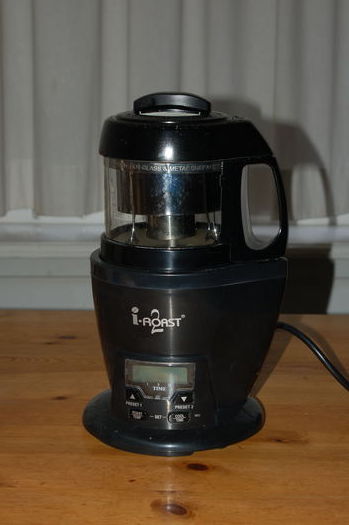
Why roast your own coffee, and what does this have to do with heirloom gardening? Good question!
More than 95% of coffee in the world is consumed stale. Coffee stays fresh about 2 weeks after roasting and 3 days after grinding. Green coffee beans on the other hand will retain their quality for a few years at least. Since many of us don’t have easy access to good quality fresh roasted coffee, roasting your own is a good alternative. Roasting a batch of coffee takes about 15 minutes, and is easy to do once you get the hang of it.
There was a time when all coffee was grown in the shade of trees. Because of the climate required for coffee, this usually meant it was grown in rainforests. This turned out to be a win-win situation for both farmers and the rainforests, because growing coffee did little damage to the environment and was economically sustainable. Since coffee is the most valuable commodity in the world after oil, it was easy for the farmer to make a fair profit. Farmers could also operate independently, because the original coffee plants were old varieties, free from intellectual property rights and needed little in the way of chemical sprays or fertilizers. Growing coffee resulted in near 100% profit for the farmers, and in a bad year the worst that happened was they didn’t make any money.
Then everything changed. Along came a new variety of coffee, an F1 hybrid, that could tolerate direct sunlight. In addition the yields of this type of coffee were much higher than the older varieties. Since this new type of coffee was a patented hybrid, it meant the farmers had to purchase the seeds instead of saving their own. In addition the plants required full sun, so couldn’t be grown in the shade of trees anymore, and it required the use of chemical sprays and fertilizers which were also patented.
For the coffee farmers, it was an opportunity to make more money, or so it seemed. By growing this new type of coffee, with possibly double or triple yields when compared with their older varieties of coffee, their higher profits more than made up for the additional costs. For many farmers the need for direct sunlight was also an easy problem to solve, by simply cutting their rainforests down.
Suddenly the world’s coffee markets became flooded with this new kind of coffee. Prices fell, and the increased yields were no longer enough to make up for the extra costs of the new coffee. Suddenly farmers found themselves not only unable to make a living wage growing coffee, but having to pay royalties on their seeds, pesticides and fertilizers just to keep their farms alive. The only farmers who could survive were the ones who could expand fast enough to grow even more, and flood the already saturated world markets with still more coffee. Suddenly there was no going back to the old ways of growing coffee.
Yes, it’s true. You can make a difference by buying Fair Trade coffee, but that only addresses part of the problem. By roasting your own coffee it is a little easier to buy shade grown coffee as direct as possible from coffee plantations or cooperatives. If you are on holiday in a coffee growing region of the world, you can buy the coffee at it’s source knowing it will last several years after you bring it home. Being able to roast your own coffee offers more possibilities to buy coffee over the Internet, from the right kinds of places.
If you have easy access to fresh roasted socially responsible coffee, having a coffee roaster may not change much. If not, and you drink a lot of coffee, it might be worth considering. If for no other reason, drinking fresh coffee instead of stale coffee makes a big difference!

